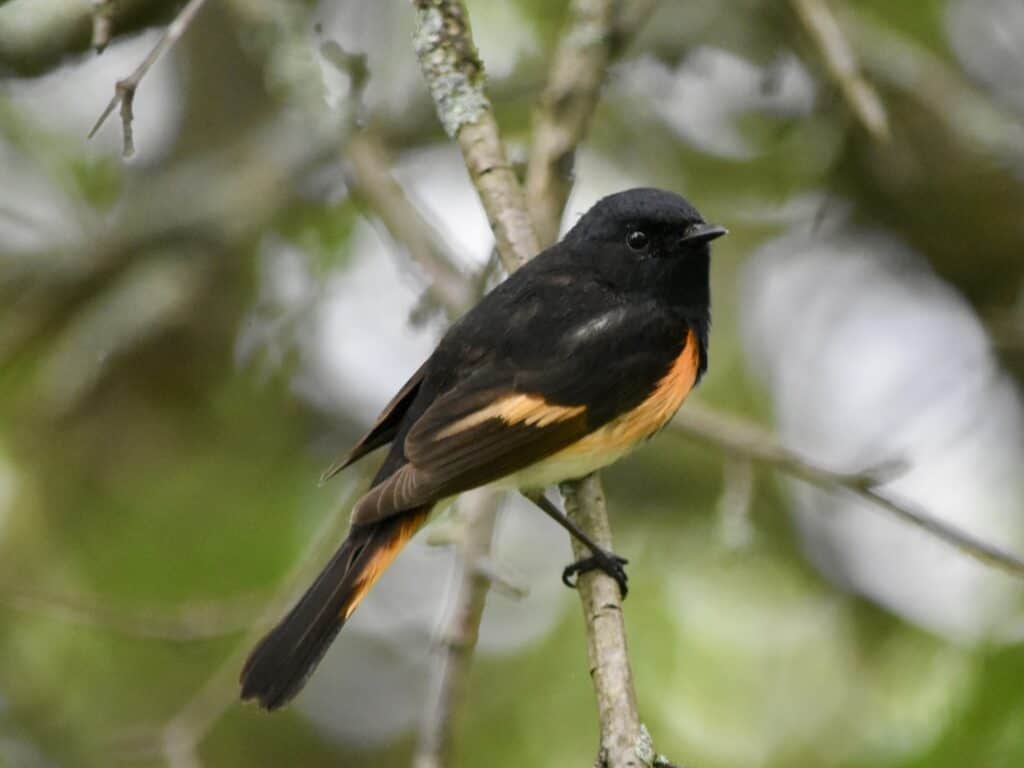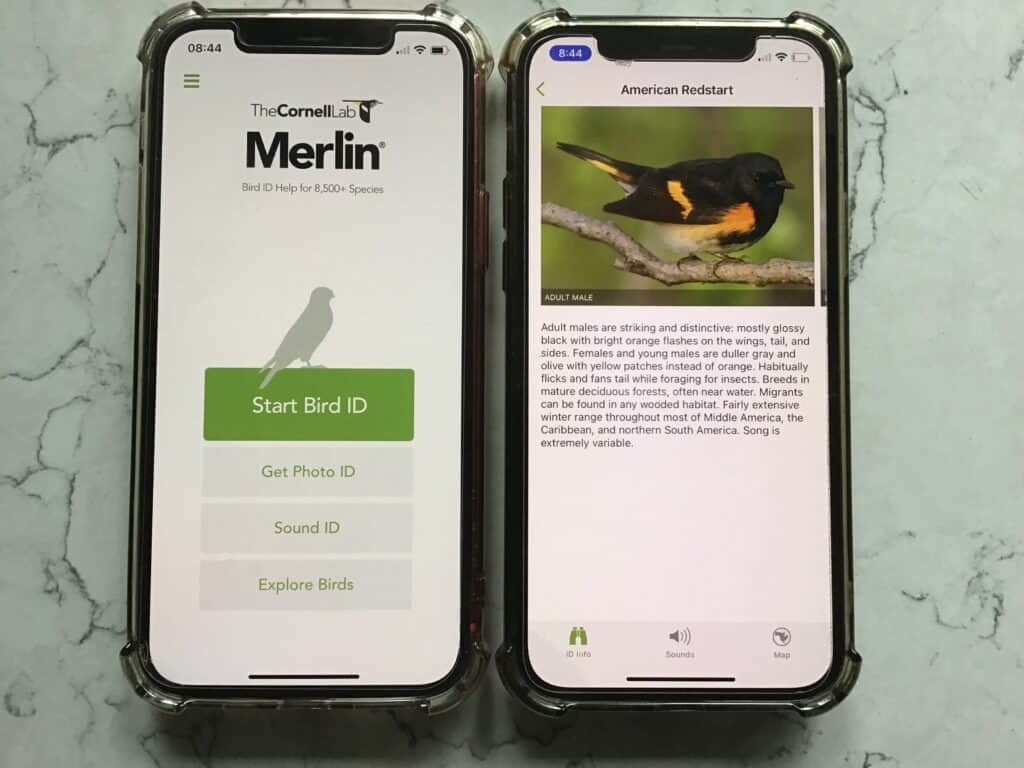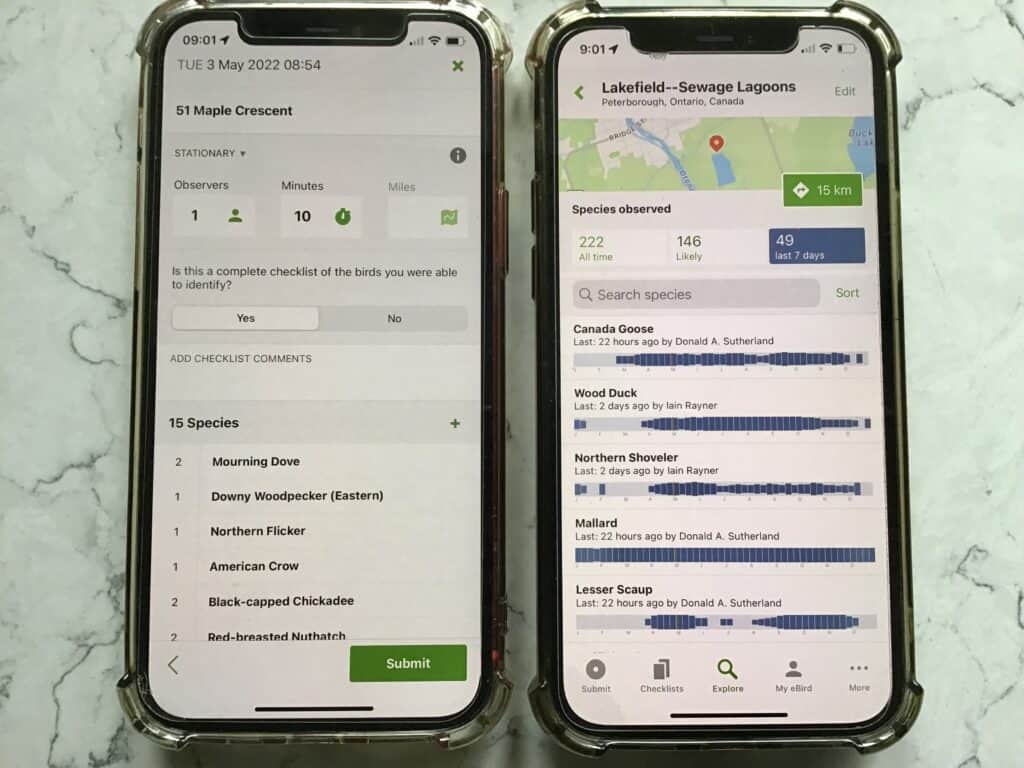Two apps make finding and identifying birds simpler and more enjoyable
Peterborough Examiner – May 6, 2022 – by Drew Monkman
I’ve been a birder nearly all my life. For nearly all of this time, my equipment was limited to binoculars, field guides, and a spotting scope. However, beyond word of mouth and eventually a telephone-tree bird alert system, I had no way of knowing what other people were seeing. I also had to lug around a field guide and rely on journals, cardboard checklists or the margins of field guides to keep track of my sightings.
Well, seven years ago my birding gear and resources got a game-changing boost, thanks to two wonderful apps called eBird and Merlin. Developed by the Cornell Lab of Ornithology and available free-of-charge for iOS and Android, they make finding and identifying birds far simpler and the entire bird-watching experience more enjoyable and rewarding. This is true for both serious birders and backyard bird enthusiasts. With the best bird-watching of the year now upon us, I could not recommend them highly enough.

Merlin Bird ID
Merlin Bird ID is an easy, accurate way to identify birds you see and hear. Unlike other bird identification apps, it is powered by eBird (see below), the world’s largest database of bird sightings, sounds, and photos.
To identify an unknown bird, Merlin asks you a few simple questions: When and where did you see it? What size was it? What were the main colours? What was it doing? Merlin will then show you photos of the most likely species for your area on that particular day of the year, based on eBird data for your location anywhere in the world. You then choose the bird that’s the closest match and, if you wish, save it to the life list feature on the app.
Merlin will also identify birds from a photo you’ve taken, either directly with your smartphone or, if you’re using a camera, using a snapshot of the photo displayed on your camera’s screen. With the Sound ID feature, you simply click on the microphone and a list and photo of the birds singing around you will magically appear. It’s wonderful to just step outside or walk a trail, click on Sound ID, and see the names of all the avian voices filling the air. By playing the Merlin recording of a given song on your phone at full volume, the bird in question will often come in quite close. Just be sure not to harass it.
I love another feature on Merlin called “Explore Birds.” It provides photos of all the likely birds in your area along with ID information, songs and calls, and a continent-wide map of where the species is found at different times of the year. If you’re traveling to a different part of the country or a different country all together, you can even download “bird packs” of all the species found there. On my recent trip to Central America, I made full use of the Costa Rica pack. Without it, I would have struggled to identify many of the 201 species I saw and heard.

eBird
Another treasure-trove of birding resources comes courtesy of eBird. In brief, it is a simple, organized way to keep track of all your bird sightings. But it’s also much more. eBird will help you find a lot more birds by providing the location of local birding “hotspots” as well as the latest sightings in your region. By submitting checklists, you’ll also be contributing to an international bird database used by scientists, conservationists, and educators. Never has this data been more important than now.
eBird can be accessed via a website (eBird.org) or through the app. The latter allows you to collect and submit bird observations directly from the field. You’ll be presented with a checklist of likely birds for that date and region. If you prefer, you can also do this from the website when you get home. You simply enter when, where, and how (e.g., stationary, traveling) you went birding and the species you found.
eBird will also make it much easier to find other species you’re interested in. You can receive daily email alerts of rare birds that have turned up as well as birds you’ve yet to see. A feature called “My eBird” gives you access to your life list and year list totals, past checklists, locations, photos, sounds, and much more.
One feature of eBird I really like are the bar charts. For a given region or county, the charts show what species are present when and how common they are. Here’s an example of how it works. Using the app or website, click on Explore. Choose Explore Regions and enter Peterborough County. You then click on Bar Charts and choose the desired date range such as Entire Year. The higher the green bar, the more common the bird is.
To get started with eBird, I encourage you to check out “How to use eBird: A Beginner’s Guide” on YouTube. There is also a free “eBird Essentials” course at academy.allboutbirds.org

Thanks to both of these powerful apps, you’ll find yourself motivated to get out birding more often and to find new species. Be careful, though. It can become an addiction!
Activities
To get to know Merlin and eBird better, try some of the following activities. Many will appeal to the entire family.
- How many birds can you identify in your yard, in your neighbourhood, or any other location you visit regularly.
- How many different species can you find in a day, month, season, or year?
- Go to “Top hotspots” on the page for the Peterborough region for a list of the best birding locations. Get out and explore a few such as the Lakefield Sewage Lagoon.
- Using Merlin, have a family bird quiz by showing a photo or playing the song of familiar birds.
- Here are some common – and very vocal – spring songbirds in Peterborough neighbourhoods and especially along rail-trails like Rotary-Greenway. See if you can learn them by sight and sound: northern flicker, red-eyed vireo, American robin, gray catbird, blue jay, house wren, song sparrow, chipping sparrow, northern cardinal, yellow warbler, and American redstart.
- A final tip: Don’t forget to use “pishing.” Repeat “pshhhh” seven or eight times in a row (i.e., pshhhh, pshhhh,…), stop to catch your breath, and then do it again. Vary how loud you pish. Chickadees, sparrows, and warblers are especially receptive.
CLIMATE CHAOS UPDATE
Hope: Clean energy spending earmarked by governments in response to the Covid-19 crisis has risen by 50% over the past five months and now stands at over USD 710 billion worldwide, according to the International Energy Agency (IEA). This level of short-term government spending keeps the door open for the IEA’s global pathway to net zero emissions by 2050. See https://tinyurl.com/yc2yv2c6
Upcoming events: On May 9 from 7 to 8 pm, Deborah Pearson will speak at 4RG Meets. She will explain how to make your yard more resilient to weather extremes and discuss practices to support biodiversity and reduce your carbon footprint. Register by emailing 4rgmeets@gmail.com.
Carbon dioxide: The atmospheric CO2 reading for the week ending April 30 was 420.19 parts per million (ppm), compared to 419.68 ppm just one year ago. The highest level deemed safe for the planet is 350 ppm. The steady upward trend in atmospheric CO2 continues: Pre-industrial (280 ppm), 1912 (300), 1988 (350), 2010 (390), 2014 (400), and 2020 (413). Rising CO2 means more heating and climate chaos ahead.
Take action: We need to do everything we can to assure that on June 2 we elect a government that puts action on climate and environmental protection front and centre. It is NOT Doug Ford’s Progressive Conservatives. Go to https://forourgrandchildren.ca/ and click on Ontario Provincial Election Actions for a list of things you can do right now.